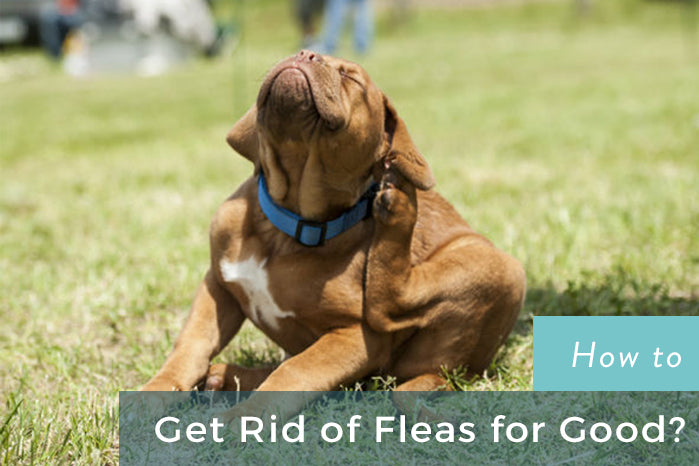
How To Rid Your Home Of Fleas For Good
Fleas are something every pet owner dreads. The sight of one leaping onto you from your armchair is enough to start a frenzied panic down to the local store to pick up flea-killing supplies. And just imagine if you spot one in your bed! Eek!
But don’t panic. With a little bit of knowledge, you can fight back with skill. Here’s everything you need to know about getting rid of fleas from your home:
The lifecycle of a flea

Before you start on your mission to rid your home of fleas, it helps to first know a little about the lifecycle of a flea. All too often, people assume that a quick drop of flea killer on the back of their dog's neck will be enough to stop the plague, but then wonder why their dog has fleas again after just 2 weeks. Only by educating yourself about the lifecycle of a flea can you truly begin to understand why this happens.
The egg stage
Female fleas lay their eggs on the host (your cat or dog). Because these don’t get cemented to the hair, as is the case with human head lice, they instead drop off the host and into the carpet, bedding or maybe even your sofa. The eggs will then hatch in 2 - 12 days, depending on the temperature.
The larvae stage
Once the eggs hatch, they live in the area they were laid, in what’s known as the ‘larvae stage’. This can last from 4 - 24 days, dependant on the time of year. In the summer, it will be shorter (hence the reason for a surge in flea infestations around this time).
At this time, the fleas are tiny, white in color, and don’t have any legs. What they do have, however, is a very powerful mouth - and they use it to relentlessly feed on flea feces and eggs until they’re fully grown. Interestingly, they cannot survive if they don’t manage to eat both of these types of food - so imagine the damage you could do to their lifecycle if you simply hoovered on a daily basis.
The pupal stage
Once it’s fully grown, the flea larvae spins a cocoon and enters the pupal stage. Usually, they stay in this state for 4 - 14 days, after which the adult flea emerges.
The adult stage
Once hatched, the adult flea is capable of jumping a massive 7 inches upwards and 13 inches forwards, making light work of attaching itself to any passing dog or cat. Once on the host, it will suck up to 15x its body weight in blood and lay around 50 eggs per day. With this system in place, it’s easy to see how an infestation can take hold quite quickly.
How to get rid of a flea infestation in your home

In order to get to the bottom of a flea infestation quickly, you need to approach the problem from all angles. That means you can’t just pop a flea collar on your pet and hope for the best. This won’t eradicate the problem due to the fact that the eggs, larvae, and pupae will still be lying dormant in your carpets and the pet’s bedding. By the time they emerge as adult fleas, that flea collar will probably be worn out and ineffective, which is a recipe for a new infestation in itself.
Treat the pet
The purpose of treating the pet is to kill the adult fleas and stop the egg production line in its tracks. Of course, this will only kill fleas while they’re actually adult fleas. It’ll do nothing to stop the emergence of flea eggs, larvae or pupae getting ready to hatch around your home. But nevertheless, it’s still an essential step.
Unfortunately, buying basic flea treatment from your local pet store can be a waste of money. Often, these products don’t contain an effective poison, or the fleas are simply immune to it. For the most powerful products, you’d be best served by visiting your local chemist or veterinary practice and asking what they would recommend.
Treat the home

Hopefully, by now you understand the absolute importance of treating the home. ¾ of the flea's life cycle is spent on your carpet or your pet’s bedding, so it makes sense to target them at this stage even more so than treating the pet itself. After all, if flea eggs never survive until adulthood, the cycle cannot continue to happen.
As with other flea treatments, we always recommend buying from a chemist or veterinary surgery. Ask for their most effective and recommended product for the home. In most cases, this will be in the form of a spray, powder, or both.
Vacuum every day
Of course, the fewer eggs, larvae, and pupae there are lying around your home, the better. So vacuum every day, and change the vacuum bag often. This is an extremely effective way of stopping fleas in their tracks.
Wash all bedding on a regular basis
Your dog probably spends most of his time in his bed, and for that reason, it’s absolutely vital that you not only vacuum, but also physically wash this bed on a regular basis. Flea eggs die at a temperature of 95°F (35°C), meaning you can wipe out thousands in one fell swoop by simply popping the dog bed in the washing machine.
For this, of course, you will need a bed which can withstand multiple washes. It’s little use buying a dog bed which can’t be washed as many times as necessary to keep fleas at bay. That’s exactly why we only sell washable dog beds at PLS Birdsong.
Be proactive, not reactive

Most dog owners believe it’s an inevitable part of having furry friends in your house that you will encounter a flea infestation from time to time. However, that’s not quite true. The truth is, if you’re proactive in your approach towards flea control, it’s perfectly plausible that you can, in fact, get by without ever having to experience the little critters.
The secret is to treat your pet and home on a regular basis. You may not have to be so aggressive with this during the winter months, but spring and summertime are a real cause for concern as the flea’s lifecycle speeds up and they find it easier than ever to reproduce quickly as temperatures rise.
Final thoughts
Left to their own devices, fleas can and will take over your pets and home. That’s why it’s down to you to keep on top of the issue before it becomes a huge one. And remember, just because you’ve treated your dog, his bed and the rest of the house once, it doesn’t mean you can lie back and relax about the issue.
Don’t forget, cats also carry fleas. If you have multiple pets, be sure to treat each and every one of them, plus every part of the house they inhabit. Pay particular attention to bedding and carpets, and never use a dog-specific treatment on a cat (or vice versa). Flea treatments contain different poisons dependent on the species they’re intended for, with some dog flea treatments proving fatal to cats.
Overall, keep in a good routine of vacuuming daily, washing bedding often and using flea treatments on pets and soft furnishings routinely. Done on a regular basis, you should have nothing to worry about when springtime comes around!






